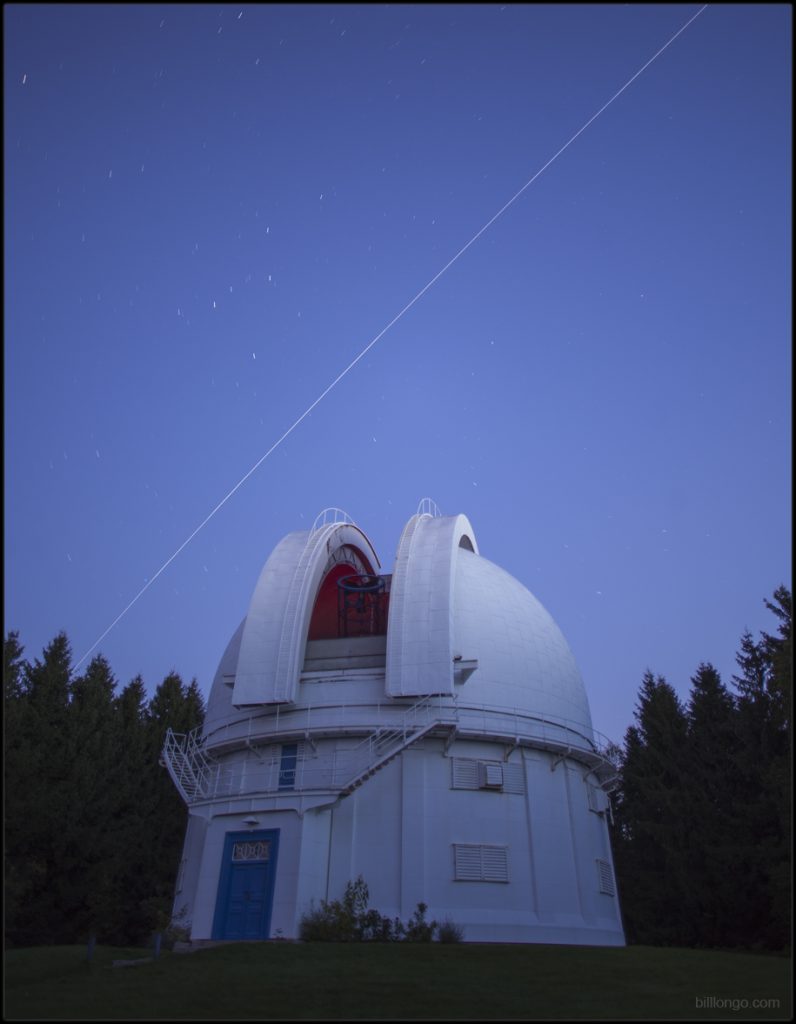Greater Toronto Area Space Station Flyovers for the week of December 13th, 2020

Artificial satellites are visible because they are high enough to be bathed in sunlight while the sun is below the horizon for earthbound observers. When the geometry is just right, brilliant beams of sunlight are reflected to Earth from flat, shiny surfaces on the spacecraft – which we see as a steady point of light that crosses the night sky in mere minutes.
Low Earth orbiting satellites (LEOs) like the space station can only be seen within an hour or two of dusk and dawn (even though they are passing overhead at all hours of the day and night). Satellites with higher orbits can be seen throughout the night. Geostationary satellites such as telecom and satellite television transmitters need to broadcast toward specific regions of the Earth, so they are placed in very remote orbits that hold them fixed at a specific altitude and azimuth in the sky.
Engineers do not bother attaching lights to satellites. If you see a night sky object that has flickering or flashing lights, it’s an aircraft. Decommissioned satellites and space “junk”, such as spent rocket boosters, can smoothly vary in brightness if they are tumbling.
A very good website for satellite predictions is www.heavens-above.com. Click on the Location link and enter your geographic location – manually, or by dropping a pin on the provided map. Then return to the main page and select from the provided list of object types, such as “ISS”. Apps such as Sputnik!, ISS Detector, and Orbitrack will put satellite predictions in your pocket, alert you of imminent passes, and even show you where in the sky to look. The SkySafari app also includes an extensive satellite database.
The ISS (or International Space Station) is visible gliding silently over the GTA this week. Some apps label the ISS as Zarya, since that was the first piece of it to be orbited – by the Soviet Union. The best passes at (mostly) convenient times are listed below. If you can’t see the station at the start given start time, be patient. The station will become most visible once it’s a bit higher.
(Note: The more negative the Mag. number, the brighter it will look. The larger the Max Alt. number, the higher up in the sky it will be!) The higher and brighter passes are highlighted with “!!”. (Data adapted from www.Heavens-above.com. If you enter your location in their website, you will get a list of the passes for your location.) All the times below are expressed in Eastern Time.
| Date | Start & End Times (EST) | Direction of Travel | Max Alt. | Mag. |
| Sat, 19-Dec | 6:36:08 am to 6:41:37 am | moves S to E | 23° | -1.1 |
| Sun, 20-Dec | 5:49:27 am to 5:53:17 am | moves SSE to E | 14° | -0.7 |
Keep looking up, and enjoy the sky when you do. I love questions and requests. Send me some!
2 Responses
Hello, Today December 20, 2020 around 1 am. The sky turned blue and then pink with a sound of a kind of electric explosion, like vibration. After 3 min it happens again but this time the sky was pink. Do you know what it could be? I never have seen something like that. I am located in Oakville ON Canada.
Hi, Marcela. Interesting- it doesn’t sound like you witnessed an astronomical phenomenon. Perhaps it was a transformer explosion – although that should’ve made the news.